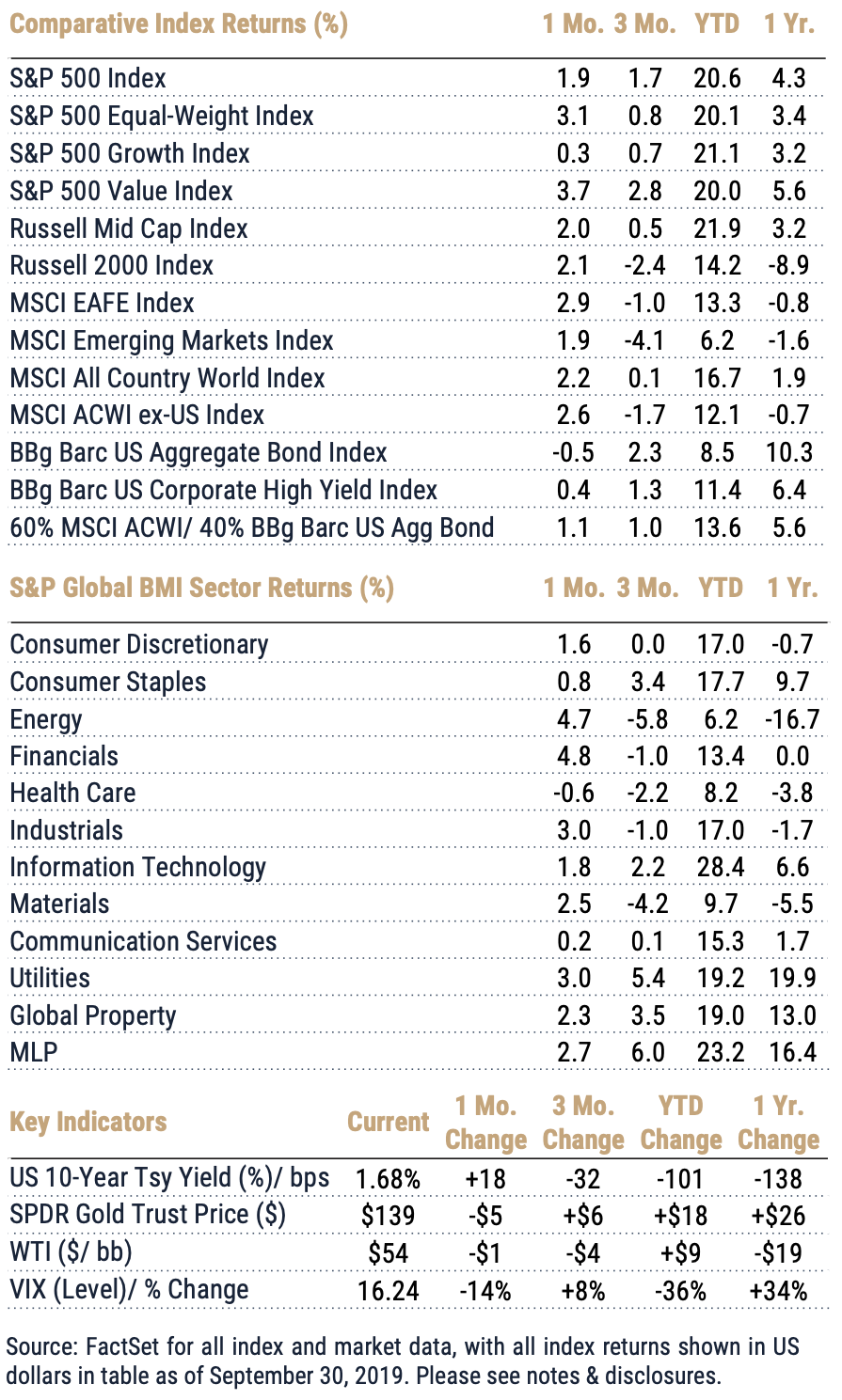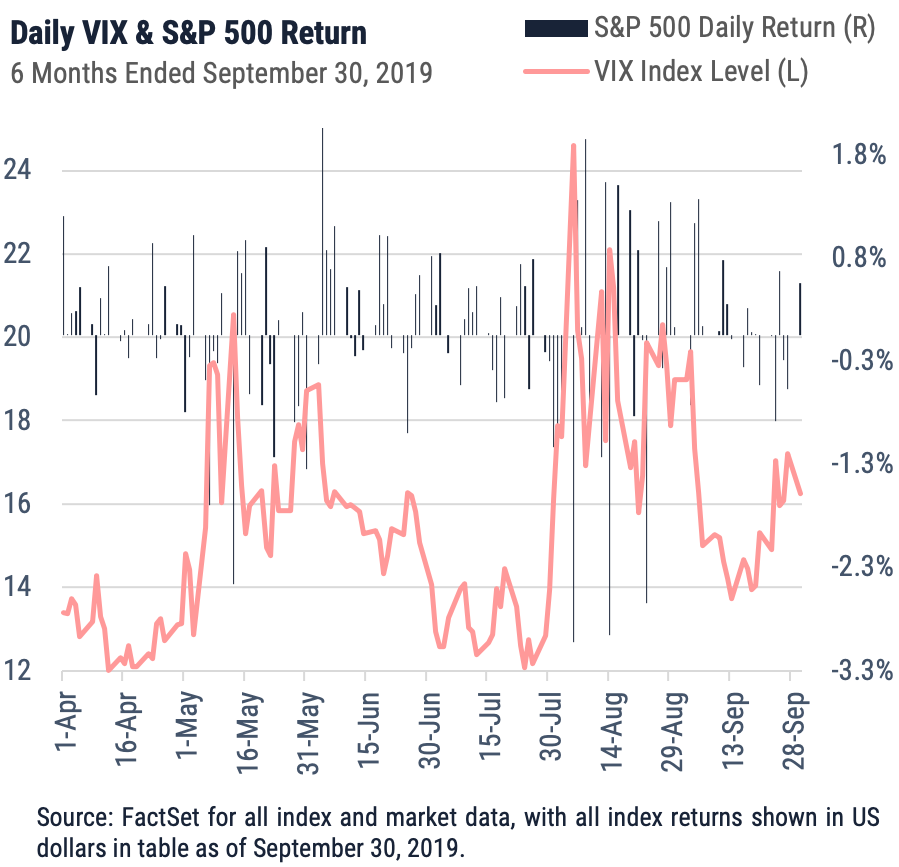Global Equity Market Review: 3Q 2019
September results may have teased long-awaited equity rotations – with value topping growth, small-cap outperforming and signs of life observed in ex-US stocks – but 3Q overall evidenced the same themes and performance drivers from 2Q. Albeit more acute in 3Q, equity performance patterns were comparable; as shown in the below chart, markets opened each quarter on a positive note before selling off mid-period and ultimately bouncing back on continued accommodation by central banks.

US large cap, as measured by the S&P 500, led equity markets with a gain of 1.7% during the period, exhibiting an interesting mix of positive momentum in value and negative momentum in smaller names. Global equities posted a return of 0.1%, propped up entirely by the US as developed international stocks (as measured by the MSCI EAFE) shed one percentage point and emerging markets fell 4.1%, combining for a negative USD result outside the US. Global yields rose in September but with further easing and stimulus global, bonds rose during the quarter overall (+0.7% for the Global Aggregate), besting stocks.
Following an overall positive result in a quiet July, August saw volatility uncorked and equity markets capitulate as the US-China Trade War escalated and investors connected the dots between worrying aspects of the global macro picture. The month’s day-to-day progress seemed to reflect a mix of profit-taking and more decisive risk-off selling as investors weighed the adequacy of a Fed-led global monetary pivot against mounting pressure from various trade skirmishes and structural headwinds globally. Bonds rallied and the US 30-year Treasury notched an all-time closing low, dipping below 2%. The Treasury trade retraced a bit in mid-September, posting a technical correction as equities strengthened over several sessions, but the 10-year yield ultimately closed the quarter down around 30 basis points.
As shown in the below chart, from a trading perspective August’s result was less of a gradual slide than it was a ping-pong match between short-term support and resistance; 11 of the month’s 22 trading sessions closed up or down 1% or greater (16 saw intra-day moves greater than 1%), and the S&P averaged (in absolute terms) a daily move of 1.11%. The CBOE VIX Index – or so-called “Fear Index” – on August 5th hit 25, roughly the level seen in an October 2018 sell-off that preceded a more comprehensive meltdown in December. September, by contrast, saw just two sessions with moves greater than 1% and averaged (in absolute terms) a daily move around 40 basis points, while the VIX traded in much more modest range.

Results were mixed at the global sector level, clearly articulating pain points relative to the US-China Trade War (strong September rallies couldn’t undo August’s damage in the Industrials, Materials and Energy sectors). Health Care, which fell 2.2% during the quarter, was the only sector to post negative returns in each month (including an August sell-off where other defensive industries posted gains); the sector has struggled with US politics-driven pressure on the outlook.
US stocks fared better than ex-US peers, with a long-disfavored value factor driving excess upside in the two positive months (but underperforming growth significantly in August). The equal-weight S&P 500 index (+0.8%) lagged the cap-weighted index, as did mid-caps (+0.5%); small caps (-2.4%) declined outright. All said, disaggregated US equity performance clearly articulated a rotation to pure value characteristics; case in point, in September the S&P 500 Pure Value Index (a concentrated index with stricter value criteria) gained 6.1% vs. 3.7% for the traditional value index.
Currency was a major driver of international equity performance in 3Q, blunting or reversing positive numbers, exacerbating losses and driving country-level dispersion (between USD & local returns) as wide as 850 basis points at a country level – such was observed in Brazil. Ex-US stocks overall returned -1.7% during the quarter, faring substantially worse in dollar than in local currency terms (+0.9%) as the USD strengthened against most currencies, including a devalued Chinese renminbi, struggling Indian rupee, sliding Brazilian Real and free-falling Argentine peso. July’s currency spread (favoring the dollar) was nearly 150 basis points for that index, while August tacked on another 90 basis points of currency-driven dispersion. Developed international stocks, as measured by the MSCI EAFE, posted -1.0% for 3Q in USD terms but +1.8% in local terms, as Japanese Yen appreciation hedged some of the drag. While Hong Kong, roughly 4% of the EAFE index, felt only modest headwinds from USD strengthening, that country fell nearly 12% during a quarter marked by at times-convulsive pro-democracy protests. Currency impacts deepened modest losses in China, India and Brazil (each down around 5% USD), and the MSCI Emerging Markets Index fell around 4.1% USD (-1.9% local) for the quarter.
Index Returns – all shown in US dollars
All returns shown trailing 9/30/2019 for the period indicated. “YTD” refers to the total return as of prior-year end, while the other returns are annualized. 3-month and annualized returns are shown for:
- The S&P 500 index is comprised of large capitalized companies across many sectors and is generally regarded as representative of US stock market and is provided in this presentation in that regard only.
- The S&P 500® Equal Weight Index (EWI) is the equal-weight version of the widely-used S&P 500. The index includes the same constituents as the capitalization weighted S&P 500, but each company in the S&P 500 EWI is allocated a fixed weight - or 0.2% of the index total at each quarterly rebalance. The S&P 500 equal-weight index (S&P 500 EWI) series imposes equal weights on the index constituents included in the S&P 500 that are classified in the respective GICS® sector.
- The S&P 500 Growth Index is comprised of equities from the S&P 500 that exhibit strong growth characteristics and is weighted by market-capitalization.
- The S&P 500 Value Index is a market-capitalization weighted index comprising of equities from the S&P 500 that exhibit strong value characteristics such as book value to price ratio, cash flow to price ratio, sales to price ratio, and dividend yield.
- The Russell 3000 Index tracks the performance of 3000 U.S. corporations, determined by market-capitalization, and represents 98% of the investable equity market in the United States.
- The Russell Mid Cap Index measures the mid-cap segment performance of the U.S. equity market and is comprised of approximately 800 of the smallest securities based on current index membership and their market capitalization.
- The Russell 2000 Index is a market-capitalization weighted index that measures the performance of 2000 small-cap and mid-cap securities. The index was formulated to give investors an unbiased collection of the smallest tradable equities still meeting exchange listing requirements.
- The MSCI All Country World Index provides a measure of performance for the equity market throughout the world and is a free float-adjusted market capitalization weighted index.
- The MSCI EAFE Index is a market-capitalization weighted index and tracks the performance of small to large-cap equities in developed markets of Europe, Australasia, and the Far East.
- The MSCI Emerging Markets Index is a float-adjusted market-capitalization index that measures equity market performance in global emerging markets and cannot be purchased directly by investors.
- The S&P Global BMI sector indices are into sectors as defined by the widely used Global Industry Classification Standards (GICS) classifications. Each sector index comprises those companies included in the S&P Global BMI that are classified as members of respective GICS® sector. The S&P Global BMI Indices were introduced to provide a comprehensive benchmarking system for global equity investors. The S&P Global BMI is comprised of the S&P Emerging BMI and the S&P Developed BMI. It covers approximately 10,000 companies in 46 countries. To be considered for inclusion in the index, all listed stocks within the constituent country must have a float market capitalization of at least $100 million. For a country to be admitted, it must be politically stable and have legal property rights and procedures, among other criteria.
- The Barclay’s US Aggregate Index, a broad based unmanaged bond index that is generally considered to be representative of the performance of the investment grade, US dollar-denominated, fixed-rate taxable bond market.
- The Bloomberg Barclay’s US Corporate High Yield Index, which covers the USD-denominated, non-investment grade, fixed-rate, taxable corporate bond market.
Key Indicators
Key Indicators correspond to various macro-economic and rate-related data points that we consider impactful to equity markets.
- The US 10-Year Treasury Yield (%)/bps, is the return on investment for the U.S. government’s 10-year debt obligation and serves as a signal for investor confidence.
- SPDR Gold Trust Price ($), is an investment fund that reflects the performance on the price of a gold bullion, less the Trust’s expenses.
- West Texas Intermediate, which is an oil benchmark and the underlying asset in the New York Mercantile Exchange’s oil futures contract.
- CBOE Volatility Index (Level)/% Change, which uses price options on the S&P 500 to estimate the market's expectation of 30-day volatility.
This document is intended for informational purposes only and should not be otherwise disseminated to other third parties. Past performance or results should not be taken as an indication or guarantee of future performance or results, and no representation or warranty, express or implied is made regarding future performance or results. This document does not constitute an offer to sell, or a solicitation of an offer to purchase, any security, future or other financial instrument or product. This material is proprietary and being provided on a confidential basis, and may not be reproduced, transferred or distributed in any form without prior written permission from WST. WST reserves the right at any time and without notice to change, amend, or cease publication of the information. This material has been prepared solely for informative purposes. The information contained herein includes information that has been obtained from third party sources and has not been independently verified. It is made available on an "as is" basis without warranty and does not represent the performance of any specific investment strategy.
We consider an index to be a portfolio of securities whose composition and proportions are derived from a rules-based model. See the appropriate disclosures regarding models, indices and the related performance. You cannot invest directly in an index and the performance of an index does not represent the performance of any specific investment. Some of the information enclosed may represent opinions of WST and are subject to change from time to time and do not constitute a recommendation to purchase and sale any security nor to engage in any particular investment strategy.
Past performance or results should not be taken as an indication or guarantee of future performance or results, and no representation or warranty, express or implied is made regarding future performance or results.
Besides attributed information, this material is proprietary and may not be reproduced, transferred or distributed in any form without prior written permission from WST. WST reserves the right at any time and without notice to change, amend, or cease publication of the information. This material has been prepared solely for informative purposes. The information contained herein may include information that has been obtained from third party sources and has not been independently verified. It is made available on an “as is” basis without warranty. This document is intended for clients for informational purposes only and should not be otherwise disseminated to other third parties. Past performance or results should not be taken as an indication or guarantee of future performance or results, and no representation or warranty, express or implied is made regarding future performance or results. This document does not constitute an offer to sell, or a solicitation of an offer to purchase, any security, future or other financial instrument or product.
